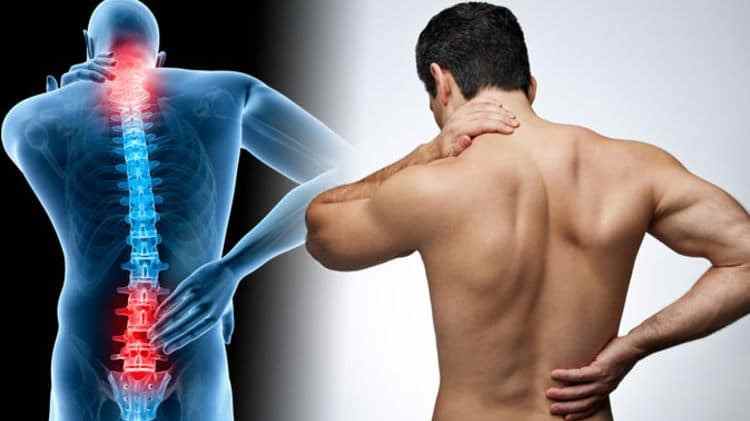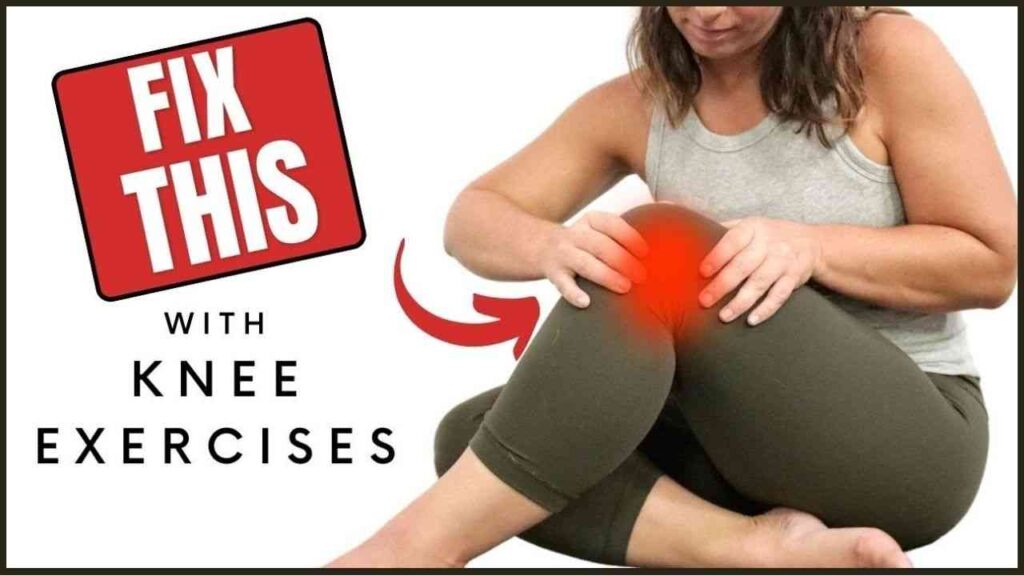Have you ever experienced a minor fall and felt pain and stiffness in your lower back the next day? If you are experiencing pain and stiffness in your lower and upper back, these physiotherapy exercises for lower back pain will help you overcome the pain and discomfort. In this article we will discuss the top effective physiotherapy exercises for lower back pain, the benefits, the proper form to perform and some useful tips for performing these, to avoid any injuries or discomfortness. Let’s go to the top list of exercises and learn how to perform those in the comfort of your own home.
Some Common Reasons for Lower Back Pain
Back pain is developed by various conditions and causes, often it develops without any reason that shows up on an imaging test. Conditions commonly linked to back pain include:
- Muscle and ligament strain
- Bulging or ruptured disks
- Arthritis
- Osteoporosis
- Ankylosing spondylitis, also called axial spondyloarthritis
- Fractures
- Structural problems
- Spondylolisthesis
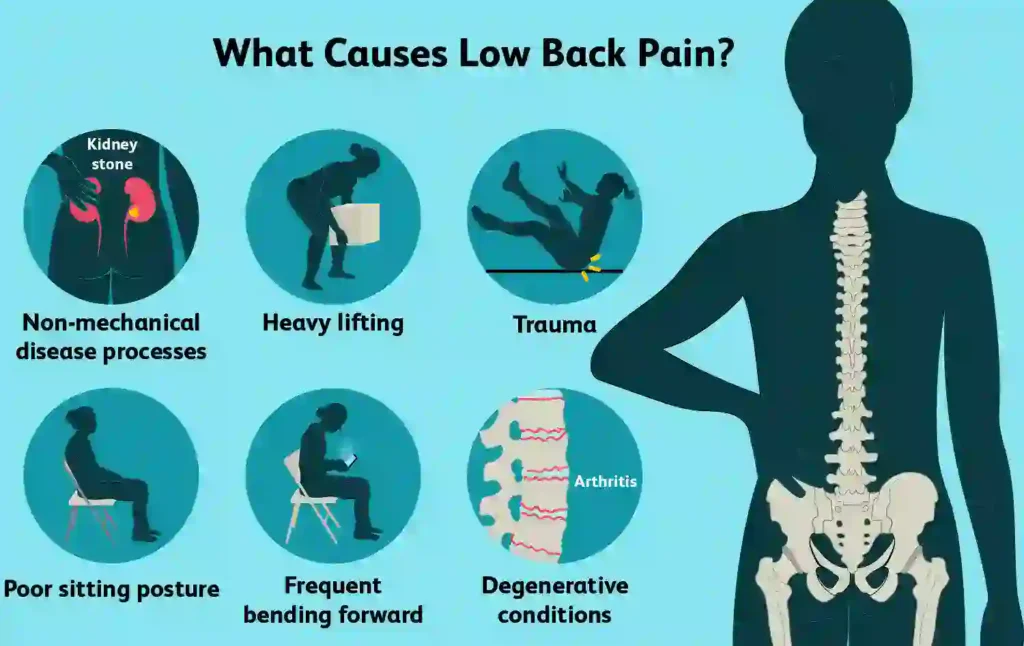
Some common risk factors of lower back pain are:
- Age
- Weight
- Overall health
- Occupation and lifestyle
- Structural problems
- Disease
- Mental health
Best Physiotherapy Exercises for Lower Back Pain Relief
When it comes to doing some exercises to ease lower back pain, it’s very important to choose a perfect set of exercises and perform them properly. If you are suffering from any chronic pain, we recommend you consult a certified physiotherapist to get a plan of physiotherapy exercises for lower back pain.
If you are experiencing general back pain, then you can follow the exercises given below. This plan is created by our certified and experienced physiotherapist which aims to reduce pain, improve flexibility, strengthen your muscles and finally help you to lead a pain-free lifestyle. Look at the exercises, to perform those properly and you can help yourself to ease lower back pain and discomfort.
1. Cat and Camel Exercise:
Why it’s beneficial:
The Cat-Camel exercise is important for your overall spinal health and mobility. This exercise, also known as the Cat-Cow, is a mobilization exercise for your spine that helps loosen the spine, enhance flexibility and improve range of motion in the lower back.
It is often recommended for individuals with lower back pain as it aids in restoring movement and preventing the lumbar spine from stiffening up, which can prolong the recovery process.
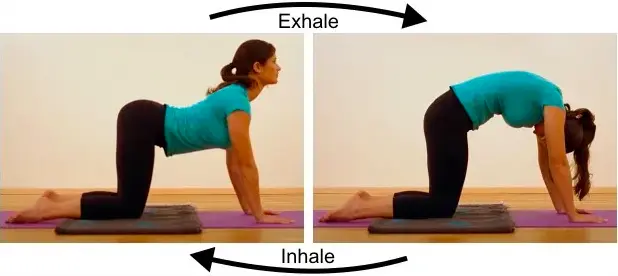
Try it:
Starting Position:
Get on your hands and knees with your knees under your hips and hands under your shoulders, ensuring your spine is in a neutral position.
Cat Position (Exhale):
While maintaining the position of your arms and legs, curve your back towards the ceiling, bringing your head and tailbone down towards the ground and closer together. Focus on fully exhaling during this motion.
Camel Position (Inhale):
After reaching the end of the Cat position, inhale as you reverse the motion into the Camel position by dropping the curve of your back towards the ground as far as possible while lifting your head and tailbone. Ensure you reach a full inhale at the end of this motion.
Return:
After performing the desired number of repetitions, return to the starting position and take 2-3 normal breath cycles.
Remember to perform these movements slowly and in a controlled manner, transitioning between the Cat and Camel positions while focusing on your breathing and maintaining proper form throughout the exercise.
While performing the Cat and Camel exercise, here are some tips to keep in mind:
- Maintain a neutral spine position throughout the movement.
- Coordinate your breathing with the motion, exhaling in the Cat position and inhaling in the Camel position.
- Engage your core muscles to stabilize your body.
- Perform the movements slowly and smoothly to avoid jerky motions.
- Listen to your body and stop if you experience any pain or discomfort beyond a gentle stretch.
By following these tips, you can maximize the benefits of the Cat and Camel exercise while minimizing the risk of injury and ensuring a safe and effective workout for your back and core muscles.
2. Bridge and Dog Exercise:
Why it’s beneficial:
Bridge and dog exercise is one of the best exercises for reducing back pain. This exercise strengthens your core, hips, and upper and lower back muscles, helps relieve low back pain and promotes a good posture. Bridge and dog exercise the whole body for an increased range of motion and enhanced flexibility.
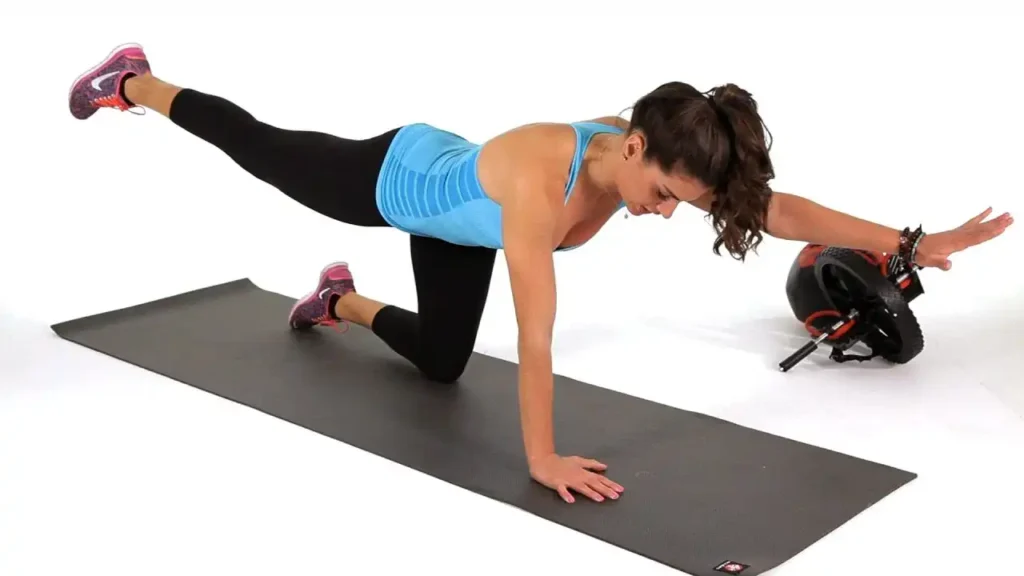
Try it:
Starting Position:
Begin on all fours with your hands directly under your shoulders and knees under your hips, ensuring a neutral spine position.
Movement:
Slowly extend your left leg straight back, keeping it parallel to the floor, while reaching your right arm forward until it is parallel.
Alignment:
Maintain a straight line from your fingertips to your toes, engaging your core muscles to stabilize your body throughout the movement.
Hold and Return:
Hold this position for about 8 to 10 seconds, focusing on balance and stability, then gently lower your arm and leg back to the starting position.
Repeat:
Perform the same movement on the opposite side by extending your right leg back and reaching your left arm forward, holding for the same duration.
Repetitions:
Aim to do 2 sets of 10-15 repetitions on each side to engage your core muscles and improve stability effectively.
While performing the bridge and dog exercise, here are some tips to keep in mind:
- Maintain a neutral spine position throughout the exercise.
- Engage your core muscles for stability and balance.
- Focus on extending your limbs parallel to the floor.
- Breathe steadily and avoid holding your breath.
- Keep your movements controlled and avoid arching your back excessively.
3. Gluteus Stretching Exercise:
Why it’s beneficial:
Gluteus stretching exercise is a beneficial exercise that helps to stretch your gluteus muscle, hips, pelvis and overall lower back. By stretching you can improve your flexibility, and range of motion which leads to reducing back pain, maintaining a good posture and maintaining a good range of motion of the hip joint.
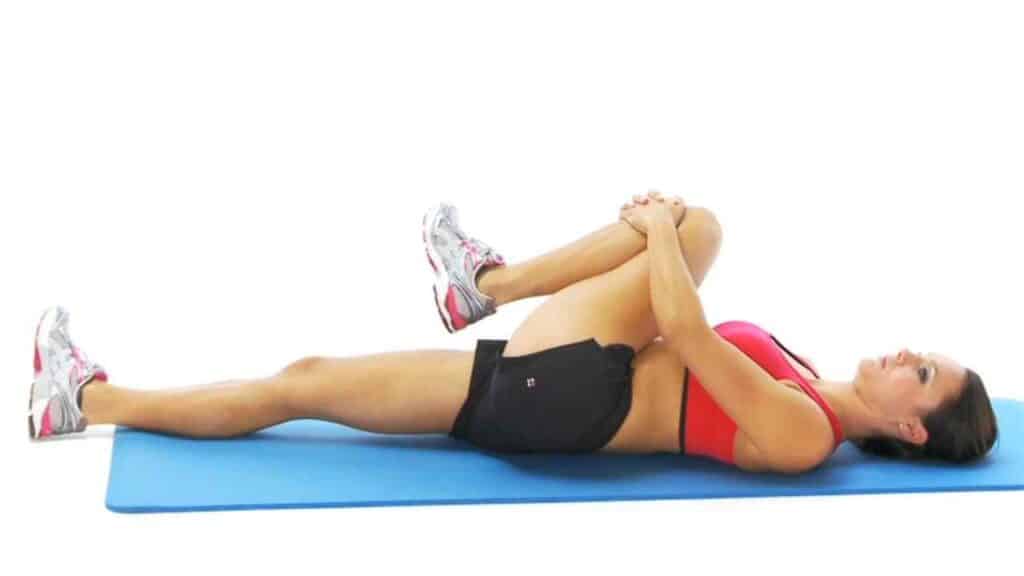
Try it:
- Position: Lie on the floor or a mat with your knees bent and feet flat on the floor.
- Execution: Cross your lower leg over the thigh of the other leg. Grasp the back of the thigh of the lower leg with both hands.
- Stretching: Pull the leg towards your torso to feel the stretch in your Gluteus muscle.
- Hold: Maintain the stretch for the desired duration.
- Repeat: Perform the same stretch with the opposite leg for balance.
This lying glute stretch is beneficial for targeting and stretching the Gluteus muscles effectively
While performing the gluteus stretching exercise, here are some tips to keep in mind:
- Keep your spine straight with shoulders over hips
- Rotate torso to the right and hug right knee with left arm
- Hold for 10-30 seconds, then switch sides
- Stand with feet together, step right foot out in front
- Keep right leg straight, bend left leg, and lean forward
- Hold the stretch for 10-30 seconds, then switch sides
- Stretch glutes and all major muscle groups before and after exercise
4. Hamstring Stretch:
Why it’s beneficial:
The hamstring is a broad muscle group, which is situated on the back of your hip bone or thigh. The action of the hamstring muscles are extension of the hip and flexion of the knee joint, as it is a conjoint muscle group. As the action continues the muscle group gets stiff, which leads to lower back stiffness and which leads to develop lower back pain. By performing the exercises you can loosen up the thigh area and pelvic area which helps to reduce pain, and stiffness and help you to recover from a poor posture.
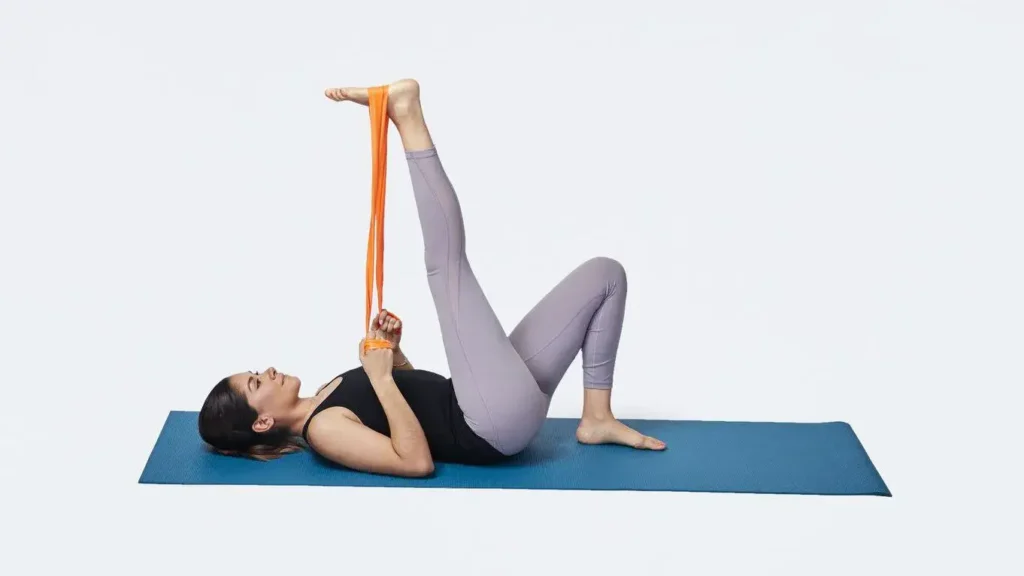
Try it:
- Lie on your back with one leg extended above you at a ninety-degree angle.
- Keep the other leg flat on the floor.
- Loop a belt, band, or rope over the ball of your foot.
- Pull on the belt to create tension in the calves and hamstrings.
- Hold this stretch for 10-30 seconds and repeat with the other leg
While performing the hamstring stretch exercise, here are some tips to keep in mind:
- Warm up before stretching to prevent injury.
- Keep your back straight and avoid rounding your spine.
- Engage your core muscles for stability.
- Breathe deeply and relax into the stretch.
- Hold the stretch for at least 30 seconds.
- Avoid bouncing or jerking movements.
- Gradually increase the intensity of the stretch over time.
5. Back Extension Exercise:
Why it’s beneficial:
Back extension exercise is one of the exercises for back pain that help to reduce pain and enhance the stability of your pelvic region and lower back. It is a strengthening exercise of the glutes and lower back which helps to enhance the stability of your lower back and pelvic region to keep the bones, ligaments and tendons in their place to perform smoothly without any restriction.
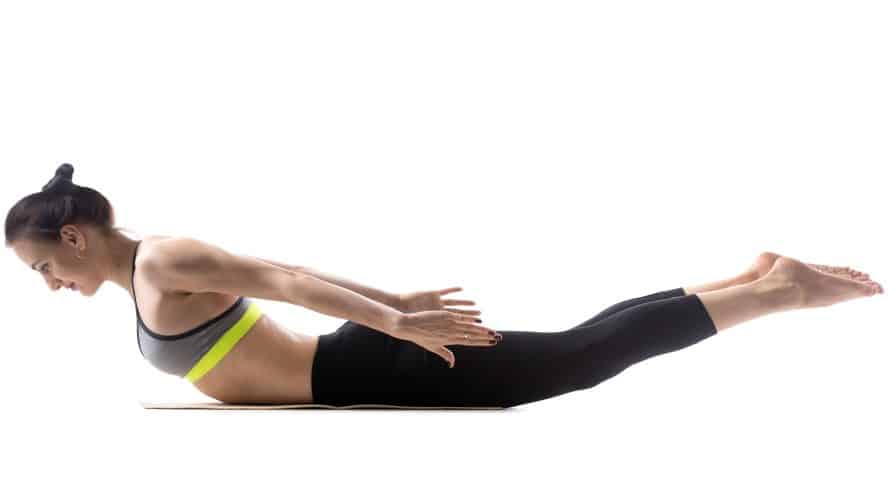
Try it:
- Lie on a mat on your stomach and straighten your legs behind you.
- Place your elbows on the ground and slide your hands forward.
- Engage your core and glutes.
- Lift your right arm and left leg slightly off the ground, or as high as you can, then relax.
- Repeat with the left arm and right leg.
- Hold each lift for a moment before relaxing.
- Keep your head and neck neutral, avoiding arching your back.
- Perform the exercise slowly and under control to prevent injury
While performing the back extension exercise, here are some tips to keep in mind:
- Perform back extension exercises slowly and with control to improve stability and strength.
- Avoid relying on momentum or swinging during the movements to maximize resistance.
- Maintain proper form by keeping your back straight, engaging core muscles, and breathing deeply.
- Hold the top position of the movement for a second to engage lower back muscles effectively.
- Gradually increase the intensity by aiming for two or three sets of 8 to 15 repetitions.
- Choose a challenging weight that allows you to perform 8 to 15 reps with the correct form if using weights.
- Consider adaptations like stability ball reverse extensions or cat-cow for variations and targeting different muscle groups
Some tips to ease some pain and keep your back healthy:
To ease some pain and keep your back healthy, consider the following tips:
- Strengthen your core muscles: Your lower back is under much stress supporting your upper body. Strengthening your core muscles can help reduce the pressure on your lower back by providing better support.
- Stretch daily: Many back problems are caused by tight muscles, which can put added stress on your entire spine. Daily stretching can promote spinal health and reduce the risk of back pain.
- Maintain proper posture: Poor sitting posture can put additional stress on your spine. If you must sit for long periods, remember to get up and walk around every so often.
- Exercise regularly: Regular exercise, such as brisk walking, can help maintain a healthy weight and keep pressure off your back.
- Lift correctly: When lifting heavy objects, engage your leg muscles instead of your back to prevent muscle spasms and pain.
- Reduce pressure on your back when sleeping: Sleeping flat on your back can put pressure on your spine. Elevating your knees slightly or placing a pillow under them can help reduce this pressure.
- Maintain a healthy weight: Extra weight puts a strain on your back, which can lead to an unnatural curvature of the spine over time.
- Quit smoking: Smoking restricts blood flow to the discs that cushion your vertebrae, which can lead to quicker disc degeneration and back pain.
- Practice mindfulness and stress reduction techniques: Stress and anxiety can worsen back pain. Engaging in mindfulness-based stress reduction, biofeedback, or cognitive-behavioural therapy can help reduce pain.
- Consider physical therapy or exercise programs: Yoga, tai chi, Pilates, aquatic exercise, and motor control exercise have been shown to help relieve back pain, improve movement, and enhance quality of life.
These tips can help ease back pain and promote a healthy back. However, if back pain persists or worsens, it is essential to consult a healthcare professional for proper evaluation and treatment.
